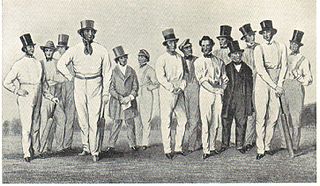Related Research Articles

Nottinghamshire County Cricket Club is one of eighteen first-class county clubs within the domestic cricket structure of England and Wales. It represents the historic county of Nottinghamshire. The club's limited overs team is called the Notts Outlaws.

Julius Caesar was an English cricketer who played in 194 first-class matches between 1849 and 1867.

William Clarke was an English cricketer and team manager who played first-class cricket from 1826 to 1855. He founded, managed and captained the All-England Eleven. He has been described as "one of certain figures who, in the history of cricket, stand like milestones along the way". Clarke was born at Nottingham and died at Wandsworth in Surrey.
1826 was the 40th season of cricket in England since the foundation of Marylebone Cricket Club (MCC). The revival of inter-county cricket gathered pace and William Clarke made his known first-class debut.
Robert Crispin Tinley was an English first-class cricketer in the mid-19th century who was recognised as one of the best slow bowlers of his time.
Frederick Peel Miller was an English cricketer. He played in first-class matches from 1851 to 1868, primarily for Surrey, for whom he appeared from 1851 to 1867, captaining them from 1851 to 1857. He was a very successful captain, Surrey being acclaimed as the Champion County in 1851, 1854, 1856 and 1857. In 1857 the county won all nine of its matches. During the remainder of Miller's career Surrey was recognised as the leading county in 1858, 1859 and 1864.

Joseph Guy was an English professional cricketer who played first-class cricket from 1837 to 1854.
An England cricket team toured Australia and New Zealand in the 1863–64 season. This was the second tour of Australia by an English team, the first having been in 1861–62, and the first to visit New Zealand. Like the 1859 team in North America, this team is sometimes referred to as George Parr's XI.

The All-England Eleven (AEE) was an itinerant all-professional first-class cricket team created in 1846 by Nottinghamshire cricketer William Clarke. Widely known by its acronym AEE, it took advantage of opportunities offered by the newly developed railways to play against local teams throughout Great Britain and made its profit by receiving payments from the home clubs. In 1852, some players broke away from the AEE to form the United All-England Eleven (UEE). Similar enterprises were launched in the following years including the United North of England Eleven (UNEE) and Edgar Willsher's United South of England Eleven (USEE) which became strongly associated with WG Grace.
Derbyshire County Cricket Club in 1875 was the cricket season when the English club Derbyshire played their fifth season. Nottinghamshire had played informal matches against Derbyshire in previous seasons, and joined Lancashire and Kent to make a third County side playing first class matches against Derbyshire in 1875. Nottinghamshire dropped out again in the 1876 season, to be replaced by Hampshire.
Alfred James Brooks was an English cricketer. Brooks was a right-handed batsman who bowled right-arm fast-medium. He was born at Sutton-in-Ashfield, Nottinghamshire.
Robert Butler was an English cricketer. Butler was a right-handed batsman who occasionally fielded as a wicket-keeper. He was born at Radcliffe-on-Trent, Nottinghamshire.
John Ernest Hill was an English cricketer. Hill was a right-handed batsman who bowled left-arm medium pace. He was born at Handsworth, Warwickshire.
John Heath was an English cricketer active in the 1840s and 1850s, making over twenty appearances in first-class cricket. Born at Lambeth, Surrey, Heath was a right-handed batsman, who played for a handful of first-class cricket teams.
George Grainger Brown was an English cricketer active in the 1850s, making over forty appearances in first-class cricket. Born at Brighton, Sussex, Brown was a right-handed batsman and an underarm bowler, who played for several first-class cricket teams.
Edward Samuel Evans Hartopp was an English first-class cricketer who played for Cambridge University, Nottinghamshire and several amateur cricket teams between 1841 and 1857. He was born at Thurnby, Leicestershire and died at Pickenham Hall, near Swaffham, Norfolk.
John Butler was an English cricketer active in first-class cricket in 1889, playing as a right-handed batsman for Nottinghamshire.
Alfred Joseph Boardman was an English first-class cricketer.
George Henry Wright was an English first-class cricketer and umpire.
References
- ↑ CricketArchive. Retrieved on 8 August 2009.